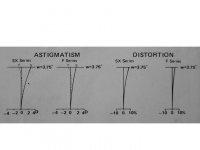Too much here for me to read,
It doesn't matter at all whether you focus at the edge or the center first. I do it both ways. You're simply following the same curve from different directions. Either way the focus difference between best focus at the edge (midpoint between tangential and sagittal foci) and best focus at the center will have exactly the same value expressed in diopters.
Henry
Henry,
when you do get the time to read what I wrote, you will find that I explained to you that this measurement does not measure curvature. It measures all other residual aberrations. As I said before, stop and think for a minute about what you are doing.
The best focus at edge represents all other aberrations minus curvature. the best focus in center represents no aberrations. Subtracting one from the other gives all other aberrations.
Frankly Henry, If you think about it just a bit longer, you can't even get curvature by starting focus out in the field. You can only get it by starting focus in the center, then moving out to the field to refocus. A little bit of thought will prove that out. That's a big difference than what you are doing.
Subtracting what you get from total would give curvature. But you never know what total is unless you start by focusing in the center.
I explained my use of units up above. As far as I know, all aberrations are measured by the degree of error they cause in the image. Therefore, I use arcseconds error. Others may do as they please.
edz
Last edited:




